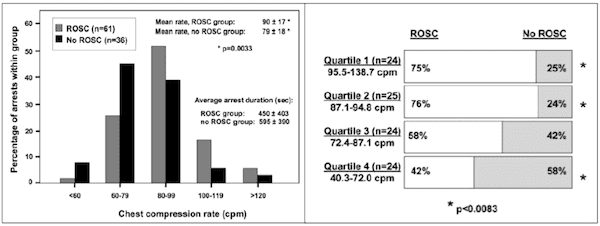
 The goal of resuscitation in cardiac arrest is to respond in a timely, effective manner that leads to good patient outcomes. Resuscitation is not taking an ACLS and BLS course and going through the motions of a code. There have been several studies looking at the quality of intubation and CPR, and their association with good patient outcomes.
The goal of resuscitation in cardiac arrest is to respond in a timely, effective manner that leads to good patient outcomes. Resuscitation is not taking an ACLS and BLS course and going through the motions of a code. There have been several studies looking at the quality of intubation and CPR, and their association with good patient outcomes.
1. Is first pass success of orotracheal intubation important? [1]
- What they did:
- Is there an association of first pass intubation success with incidence of adverse events (AEs)?
- Retrospective analysis
- 1,828 orotracheal intubations
- Single academic ED
- Primary Outcomes:
- AEs: aspiration, oxygen desaturation, dental trauma, laryngospasm, pneumothorax, esophageal intubation, hypotension, dysrhythmia, and cardiac arrest
- Results:
- Most common AE was oxygen desaturation
- First attempt success = 14.2% AEs
- Two attempts = 47.2% AEs
- Three attempts = 63.6% AEs
- Four or more attempts = 70.6% AEs
- Limitations:
- Single center study
- Retrospective analysis
- Data was self-reported which could cause recall bias and under reporting of AEs
- Conclusion: As the number of attempts increases, the incidence of AEs increases substantially
2. Does the rate of CPR matter? [2]
- What they did:
- Prospective observational study
- 3 hospitals
- 97 cardiac arrests
- Measured chest compression rates
- Primary Outcome:
- Return of spontaneous circulation (ROSC)
- Results:
- CPR rate
- CPR rate
- CPR rate of patients with ROSC 90 +/- 17
- CPR rate of non-survivors 79 +/- 18

- Limitation:
- Data collected from an observer (human error)
- Conclusion: Suboptimal chest compression rates correlate with poor ROSC.
3. How important is the End-Tidal Carbon Dioxide in cardiac arrest? [3]
- What they did:
- Prospective, observational study
- 737 cases of out-of-hospital cardiac arrest
- Recorded the partial pressure of end-tidal carbon dioxide (PetCO2) measured during CPR
- Primary Outcome:
- PetCO2 predicting restoration of spontaneous circulation (ROSC)
- Results:
- Average PetCO2 = 6.9 +/- 2.2 mmHg in patients without ROSC
- Average PetCO2 = 32.8 +/- 9.1 mmHg in patients with ROSC
- PetCO2
- Conclusions: PetCO2 > 14.3 mmHg after 20 minutes of ACLS predicts ROSC with accuracy
Summary
First pass intubation success, high-quality chest compressions at rate of 100 bpm, and PetCO2 >14.3 mmHg during CPR are important predictors for success in the resuscitation of patients in cardiac arrest. [4]
References:
- Sakles JC et al. The Importance of First Pass Success When Performing Orotracheal Intubation in the Emergency Department. Acad Emerg Med 2013. PMID: 23574475
- Abella BS et al. Chest Compression Rates During Cardiopulmonary Resuscitation are Suboptimal: A Prospective Study During In-Hospital Cardiac Arrest. Circulation 2005. PMID: 15687130
- Kolar M et al. PArtial Pressure of End-Tidal Carbon Dioxide Successful Predicts Cardiopulmonary Resuscitation in the Field: A Prospective Observational Study. Critical Care 2008. PMID: 18786260
- Abella BS. The Importance of Cardiopulmonary Resuscitation Quality. Currently Open Crit Care 2013. PMID: 23587758
The post Three Predictors of Success in Cardiac Arrest appeared first on REBEL EM - Emergency Medicine Blog.
